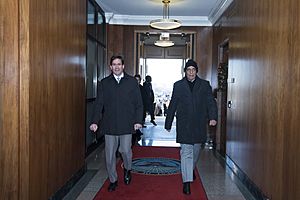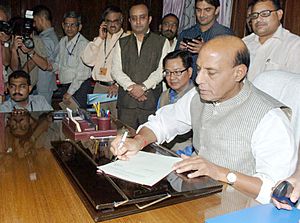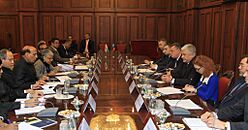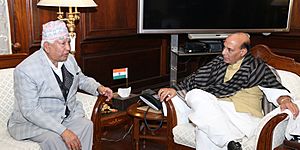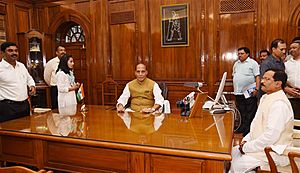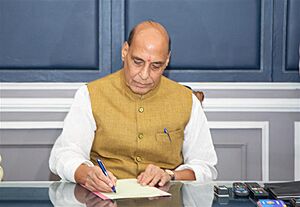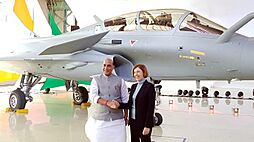Rajnath Singh facts for kids
Quick facts for kids
Rajnath Singh
|
|
|---|---|
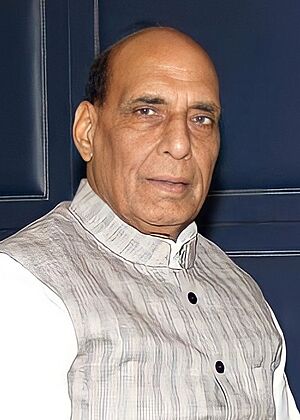
Singh in 2023
|
|
| 29th Union Minister of Defence | |
| Assumed office 30 May 2019 |
|
| Prime Minister | Narendra Modi |
| Preceded by | Nirmala Sitharaman |
| Deputy Leader of the House, Lok Sabha | |
| Assumed office 26 May 2014 |
|
| Speaker | Om Birla |
| Leader of the House | Narendra Modi |
| Preceded by | Sushma Swaraj |
| 25th Union Minister of Home Affairs | |
| In office 26 May 2014 – 30 May 2019 |
|
| Prime Minister | Narendra Modi |
| Preceded by | Sushilkumar Shinde |
| Succeeded by | Amit Shah |
| Member of Parliament, Lok Sabha | |
| Assumed office 16 May 2014 |
|
| Preceded by | Lalji Tandon |
| Constituency | Lucknow, Uttar Pradesh |
| In office 16 May 2009 – 16 May 2014 |
|
| Preceded by | constituency established |
| Succeeded by | V. K. Singh |
| Constituency | Ghaziabad, Uttar Pradesh |
| 8th National President of the Bharatiya Janata Party | |
| In office 24 January 2013 – 8 July 2014 |
|
| Preceded by | Nitin Jairam Gadkari |
| Succeeded by | Amit Shah |
| In office 31 December 2005 – 19 December 2009 |
|
| Preceded by | L. K. Advani |
| Succeeded by | Nitin Gadkari |
| 27th Union Minister of Agriculture | |
| In office 24 May 2003 – 22 May 2004 |
|
| Prime Minister | Atal Bihari Vajpayee |
| Preceded by | Ajit Singh |
| Succeeded by | Sharad Pawar |
| 19th Chief Minister of Uttar Pradesh | |
| In office 28 October 2000 – 8 March 2002 |
|
| Governor | Vishnu Kant Shastri |
| Preceded by | Ram Prakash Gupta |
| Succeeded by | President's rule |
| 34th Union Minister of Surface Transport | |
| In office 22 November 1999 – 27 October 2000 |
|
| Prime Minister | Atal Bihari Vajpayee |
| Preceded by | Nitish Kumar |
| Succeeded by | B. C. Khanduri |
| Member of Parliament, Rajya Sabha | |
| In office 26 November 2002 – 25 November 2008 |
|
| Preceded by | Balwant Singh Ramoowalia |
| Succeeded by | Kusum Rai |
| Constituency | Uttar Pradesh |
| In office 3 April 1994 – 19 April 2001 |
|
| Preceded by | Z. A. Ahmed |
| Succeeded by | Kalraj Mishra |
| Constituency | Uttar Pradesh |
| 4th National President of the Bharatiya Janata Yuva Morcha | |
| In office 1988–1990 |
|
| Preceded by | Pramod Mahajan |
| Succeeded by | J. P. Nadda |
| Personal details | |
| Born | 10 July 1951 Bhabhaura, Uttar Pradesh, India |
| Political party | Bharatiya Janata Party |
| Other political affiliations |
Janata Party (1977–1980) Bharatiya Jana Sangh (before 1977) |
| Spouse |
Savitri Singh
(m. 1971) |
| Children | 3, including Pankaj Singh |
| Residence |
|
| Alma mater | Gorakhpur University (M.Sc., Physics) |
| Profession |
|
Rajnath Singh (born 10 July 1951) is an important Indian politician. He has been the Defence Minister since 2019. He is also the Deputy Leader of the House in the Lok Sabha, which is a main part of India's Parliament.
Before this, he was the Home Minister from 2014 to 2019. He was the first person born after India became independent to hold this important job. He also led the Bharatiya Janata Party (BJP) as its President twice. Rajnath Singh started his political journey with the Rashtriya Swayamsevak Sangh.
Singh was the Chief Minister of Uttar Pradesh from 2000 to 2002. He also served as a Cabinet Minister for Road Transport and Highways. This was in the Vajpayee Government from 1999 to 2000. Later, he was the Minister of Agriculture from 2003 to 2004. He was also the President of the Bharatiya Janata Yuva Morcha, the BJP's youth wing.
He was a member of the Uttar Pradesh Legislative Assembly twice. He represented the Haidergarh constituency. He has also been a member of the Lok Sabha for Lucknow and Ghaziabad. Additionally, he was a member of the Rajya Sabha (the other house of Parliament) for two terms.
Contents
Early Life and Education
Rajnath Singh was born in Bhabhaura village in the Chandauli district of Uttar Pradesh. His parents, Ram Badan Singh and Gujarati Devi, were farmers. He went to a local school for his early education. Later, he earned a master's degree in physics from Gorakhpur University.
From a young age, he was inspired by the ideas of the Rashtriya Swayamsevak Sangh. He worked as a physics lecturer at K.B. Post-Graduate College in Mirzapur, Uttar Pradesh. He also has a brother named Jaipal Singh.
Beginning in Politics
Joining the RSS and Early Roles
Singh joined the Rashtriya Swayamsevak Sangh (RSS) in 1964 when he was 13. He stayed involved with the organization. In 1972, he became the General Secretary of the RSS in Mirzapur. Two years later, in 1974, he entered politics.
Between 1969 and 1971, he was the organizing secretary for the Akhil Bharatiya Vidyarthi Parishad. This is the student group of the RSS, in Gorakhpur. In 1974, he became secretary for the Mirzapur unit of the Bharatiya Jana Sangh. This party was the earlier version of the Bharatiya Janata Party. By 1975, at age 24, Singh was named District President of the Jana Sangh.
The JP Movement and Emergency Period
In the 1970s, Singh was influenced by the JP Movement. This movement was led by Jayaprakash Narayan. He was arrested in 1975 during the National Emergency in India. He was held for about two years because of his involvement with the JP Movement.
First Election Win
After being released from jail, Singh joined the Janata Party. This party was started by Jayprakash Narayan. He ran in the legislative assembly elections from Mirzapur in 1977. He won the election and became a Member of Legislative Assembly from Mirzapur.
Rising in the BJP
Singh became well-known in his state. In 1980, he joined the BJP and was one of its first members. He became the State President of the BJP youth wing in 1984. Then, he was the National General Secretary in 1986. He became the National President of the youth wing in 1988. He was also elected to the Uttar Pradesh Legislative Council.
Early Ministerial Roles
Education Minister (1991–1992)
In 1991, the Bharatiya Janata Party formed its first government in Uttar Pradesh. Kalyan Singh was the Chief Minister. Rajnath Singh was appointed as the Education Minister of Uttar Pradesh. He held this position for two years.
During his time as Education Minister, he introduced the Anti-Copying Act, 1992. This law made cheating a serious offense. He also updated science textbooks. He included Vedic mathematics in the school lessons.
Modernizing Education
In 1991, Singh helped rewrite history textbooks for government schools. He also added Vedic mathematics to the school curriculum. These changes were seen as being influenced by his connection to the RSS, a Hindu nationalist group. As minister, he also promoted the use of Indian languages instead of English in schools. However, he also valued learning modern languages.
Union Transport Minister (1999–2000)
In April 1994, he was elected to the Rajya Sabha. This is the upper house of the Parliament. He worked on committees related to industry, agriculture, and human resource development. On 25 March 1997, he became the President of the BJP's Uttar Pradesh unit. In 1999, he became the Union Cabinet Minister for Surface Transport.
Chief Minister of Uttar Pradesh (2000–02)
In 2000, Rajnath Singh became the Chief Minister of Uttar Pradesh. He was elected as an MLA from Haidergarh twice. He took over from Ram Prakash Gupta. After his term, the state was under President's rule for 56 days, and then Mayawati became Chief Minister.
Singh was the last Chief Minister of undivided Uttar Pradesh. His experience as education minister and his strong support from the public helped him become Chief Minister. He was also close to Atal Bihari Vajpayee and had a very good reputation. He was popular among the Rajput community in the state. Unlike some other leaders, he was known for being soft-spoken.
Key Actions as Chief Minister
As Chief Minister, Singh said that the Samajwadi Party favored certain groups for jobs. He wanted to end this unfairness. He tried to make the reservation system fairer. He aimed to help the most disadvantaged groups among the OBC and SC categories.
When Singh became Chief Minister, Uttar Pradesh had a very high crime rate. He made law and order a top priority. On 7 February 2001, Singh opened the DND Flyway. This road connects Delhi to Noida.
Resignation from Chief Minister Post
In 2002, Singh resigned as Chief Minister after two years. At that time, the state BJP government did not have a majority. After his resignation, the state was under President's rule for 56 days. Then, Mayawati became Chief Minister for the third time.
Rise in National Politics
Union Agriculture Minister (2003–04)
In 2003, Singh became the Minister of Agriculture. He also handled Food Processing in the NDA Government. This government was led by Atal Bihari Vajpayee. He faced the challenge of managing a key part of India's economy.
During this time, he started important projects. These included the Kisan Call Centre and the Farm Income Insurance Scheme. He also lowered interest rates on loans for farmers. He set up a Farmer Commission.
National President of the BJP
First Term (2005–2009)
After the BJP lost the 2004 Indian general election, they became the opposition party. After Lal Krishna Advani resigned, Singh worked to rebuild the party. He focused on the basic ideas of Hindutva. He stated that a Ram Temple would be built in Ayodhya. He praised Vajpayee's time as Prime Minister. He highlighted the developments the NDA made for ordinary people.
He also criticized the use of English in India. He said that many Indians could not participate in the economy because of the preference for English. Singh also suspended Jaswant Singh from the party. This was for praising Muhammad Ali Jinnah and disrespecting Jawaharlal Nehru's policies. Singh had held many roles for the RSS and the BJP. He resigned after the NDA lost the 2009 Indian general election.
He became the BJP National President on 31 December 2005. He held this position until 19 December 2009. In May 2009, he was elected as a Member of Parliament from Ghaziabad in Uttar Pradesh.
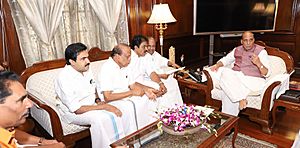
Second Term (2013–2014)
On 24 January 2013, Nitin Gadkari resigned due to corruption claims. Singh was re-elected as the BJP's National President.
Singh played a big role in the BJP's campaign for the 2014 Indian general election. He announced Narendra Modi as the party's candidate for Prime Minister. This was despite some opposition within the BJP. After the party won by a large margin, Singh resigned as party president. He then became the Home Minister.
He ran in the 2014 Lok Sabha elections from the Lucknow area. He was elected as a Member of Parliament.
Union Home Minister (2014–19)
He became the Union Minister of Home Affairs in the Narendra Modi government. He took office on 26 May 2014. He was the former president of the BJP. He was the one who named Narendra Modi as the Prime Minister candidate. After the BJP won the 2014 Lok Sabha Election, he took over from Sushilkumar Shinde. He served as Home Minister from 2014 to 2019. He has also been the Deputy Leader of Lok Sabha since 2019.
Bharat Ke Veer App
On 9 April 2017, he launched the Bharat Ke Veer website and app. He did this with Bollywood actor Akshay Kumar. This project helps raise money for the families of soldiers who have died. Bharat Ke Veer is a fundraising effort by the Ministry of Home Affairs. It supports members of the Indian paramilitary forces. Singh praised the app and was its first donor.
An official song for 'Bharat Ke Veer' was launched on 20 January 2018. Singh, Akshay Kumar, and other ministers were present.
Doklam Border Issue
Doklam is an area disputed by Bhutan and China. In 2017, China tried to build a road there. The Indian army stepped in to help Bhutan. This caused tension between India and China. Singh assured the public that the issue would be resolved. He talked with officials from the Chinese Communist Party.
Even though the issue was between Bhutan and China, India got involved when Bhutan asked for help. Singh and Prime Minister Narendra Modi openly supported Bhutan. The tension later eased. On 9 October 2017, China said it was ready to keep peace at the borders with India. This was after Singh and Defence Minister Nirmala Sitharaman visited Nathu La.
Bastariya Battalion
On 21 May 2018, he officially started the Bastariya Battalion. As Union Home Minister, Rajnath Singh attended the passing out parade. This was for the 241 Bastariya Battalion of CRPF. The event took place in Ambikapur, Chhattisgarh.
Union Defence Minister (2019–present)
Singh became the Defence Minister of India on 31 May 2019. He took over the Ministry of Defence (India) after Amit Shah became the Home Minister. As Defence Minister, Singh has focused on changing India's defense strategy. He aims to meet the growing needs of India's forces. This includes increasing the defense budget. He also wants to reduce weapon imports and make India an arms exporter.
He stated:
"India cannot put hand on hand in the issues of National Security. Now the time has come that India needs to emerge as major arms exporter."
Rafale Fighter Planes
The Dassault Rafale is a French fighter plane. A deal to buy these planes was signed in 2016 by the then Defence Minister, Manohar Parrikar. This was to make the Indian Air Force stronger. The Government of India agreed to buy 126 fighter jets.
The planes were received during Singh's time as Defence Minister. He went to France to receive the first Dassault Rafale on 8 October 2019. The first group of 5 fighter jets landed at Ambala Air Force Station. India received the second group of Rafale jets on 29 July 2020. Singh said that those who threaten India's land should be aware of India's new strength.
India-China Border Tension

Since May 2020, there has been tension between the security forces of India and China. This is over the border area of Ladakh. Singh met with officials of the Indian Army and visited the Ladakh Range. He also met with top military leaders to discuss the situation. After 20 Indian soldiers died during the 2020 China–India skirmishes in Galwan Valley, Singh met with the soldiers. He said he could not guarantee how far the tension would go. The situation was later managed.
On 30 August 2020, the People's Liberation Army again caused issues in the Ladakh area. They sent many troops to the disputed area. Chinese and Indian officials held talks in Moscow on 4 September. On 10 September, the foreign ministers of China and India met. They agreed on five points to build trust. On 21 September, another meeting took place. For the first time, an Indian Ministry of External Affairs representative was present. After 14 hours of talks, both sides agreed to stop sending more troops to the front lines.
Singh assured citizens that the situation was under control. He also said that fake news was being spread. He admitted that the Chinese Army had tried to cross the LAC.
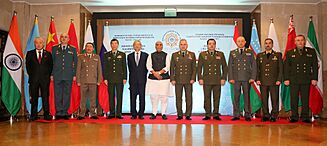
On 28 April 2023, Chinese Defense Minister Li Shangfu met with Rajnath Singh. This was part of the Shanghai Cooperation Organisation defence ministers' meeting in New Delhi. It was the first visit to India by a Chinese Defence Minister since the 2020 border clashes.
On 26 June 2025, he visited China for the Shanghai Cooperation Organisation defence ministers' meeting. This was the first visit by a senior Indian minister to China since the 2020 border clashes. During the meeting, Singh did not sign the joint declaration. He said the document did not condemn the 2025 Pahalgam attack in Kashmir.
Russia Relations
On 10 December 2024, Singh held talks with Russian Defence Minister Andrey Belousov. Singh confirmed India's commitment to making defense ties with Russia stronger.
Agnipath Scheme
The Defence Ministry started a new army recruitment plan called Agnipath. This scheme recruits soldiers for all three forces. The selected candidates are called "Agniveers". This plan is for four years for candidates aged 18-24. There were protests against the scheme. People questioned the future of the candidates. Railways were set on fire in some states. The Ministry said it was a necessary reform to lower the average age of the military. The Delhi High Court also said the government brought this scheme "In national Interest."
Military Exercises
He opened the four-day Indo-Pacific Military Health Exchange (IPMHE) conference online.
International military exercises called Vostok-2022 took place in Russia in September 2022. Countries like Russia, India, and China took part. On 28 April 2023, Singh met with Russian Minister of Defence Sergei Shoigu.
Personal Life
Rajnath Singh married Savitri Singh on 5 June 1971. They have two sons and one daughter. His son, Pankaj Singh, is also a politician. He is a Member of the Legislative Assembly from Noida, Uttar Pradesh, for the BJP. Singh is a religious man and is known for his calm behavior.
Images for kids
See also
 In Spanish: Rajnath Singh para niños
In Spanish: Rajnath Singh para niños


